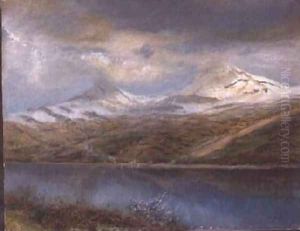Laszlo Mednyaszky Paintings
László Mednyánszky, born Ludovít Mednyánszky, was a distinguished Hungarian painter known for his poetic representation of landscapes and figures. He was born on April 23, 1852, in Beckó (now Beckov), which was at that time part of the Austrian Empire and is today located in Slovakia. Mednyánszky's family belonged to the Hungarian nobility, and his father was a baron, which allowed him to enjoy a privileged upbringing. Despite this, his works often reflected a sensitivity to the plight of the poor and the marginalized in society.
Mednyánszky's artistic talents were evident from a young age, and he began his formal training in Vienna. He later traveled extensively throughout Europe, studying and working in Paris, where he was influenced by the Barbizon school, and in Italy. He also spent time in Munich, which was a vibrant center for artists at the turn of the century. His travels and exposure to different artistic movements had a significant impact on his style, which combined elements of realism, impressionism, and symbolism.
Throughout his career, Mednyánszky painted a wide range of subjects, from landscapes and rural scenes to portraits and genre paintings. His landscapes are particularly notable for their atmospheric quality and the emotional resonance they convey. He had a unique ability to capture the moods of nature, often depicting the changing seasons, transient light effects, and the varying weathers with a delicate, almost ethereal touch.
Despite his noble roots, Mednyánszky was deeply moved by the hardships of peasant life, which he witnessed firsthand during his travels across the Hungarian countryside. This empathy is evident in his figure paintings, where he portrayed the toils and sorrows of rural laborers with both realism and compassion. His works often conveyed a sense of melancholy and introspection, which has led to comparisons with the Norwegian artist Edvard Munch.
Mednyánszky's work received recognition during his lifetime, and he participated in numerous exhibitions throughout Europe. However, his personal life was marked by struggles, including periods of financial difficulty and a complex private life that remained enigmatic to many.
László Mednyánszky died on April 17, 1919, in Vienna. His legacy lives on through his profound and evocative paintings, which have been exhibited in many galleries and museums. His work continues to be celebrated for its emotional depth and its poetic, often haunting, representation of both the beauty and the sorrow of the human condition and the natural world.
